Three great driving holidays on the Emerald Isle
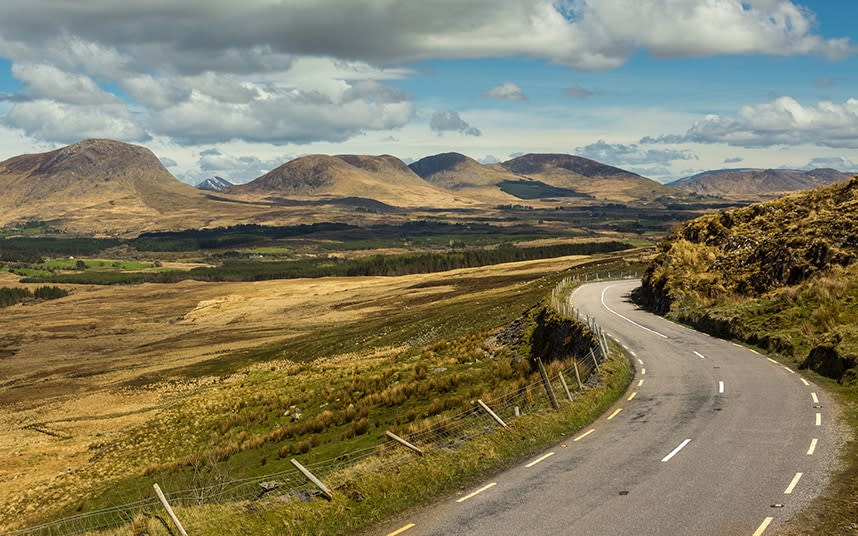
Time was when a sailing ship could take days, in the teeth of contrary winds, to make the sea crossing from Britain to Ireland. Today’s travellers have it rather easier: you can hop from Cairnryan to Belfast and Holyhead to Dublin in a little over two hours, and from Fishguard or Pembroke to Rosslare in four hours.
And there are other reasons to opt for a sail-and-drive trip across to Ireland. You don’t have to weigh your suitcases or wearily fill those miniature plastic airport bags with shampoo and moisturiser: instead, you can fill the car with suitcases and sail west, on one of an increasingly sophisticated fleet of ferries.
Most impressive of all is Irish Ferries’ €150 million (£130 million) W B Yeats, due to operate on the Holyhead-Dublin route from September 2018. Some 640ft in length and weighing 55,000 tonnes, the giant “cruise ferry” has suites with outside balconies, a range of restaurants and bars, a club class lounge and an on-board cinema – facilities to rival many cruise ships.
Once in Ireland, however, you won’t have to readjust your sense of geographical scale: distances are nicely manageable; and traffic tends to be lighter. And make room in the boot for purchases of the quality foodstuffs that are the result of a gastronomic revolution: golden rapeseed oil, Irish cheeses, smoked fish and meats, jams, breads and chutneys.
For British visitors, Ireland beguilingly mingles familiarity with difference: the idiom, accent, and rhythms of speech are all different; and while visitors to Northern Ireland encounter the road signs and red postal boxes of home, travellers in the Republic will note bilingual road signs, distances in kilometres, and other indicators of a foreign land. All the more reason to visit – soak up this difference, familiarity, and the sheer grandeur of the landscapes. Here are three circular itineraries – from each of the key entry ports, to help you make the best of Ireland’s roads.
At a glance | Ferries to Ireland
Coast and culture out of Belfast
Embark on the Antrim Coast Road, which carves a serpentine route along the north-east shoulder of Northern Ireland. Break your journey at The Gobbins (thegobbinscliffpath.com), a cliff path hacked into the rock of Islandmagee; and in Ballycastle, with its views across to Rathlin Island and Scotland, before turning west towards the Causeway Coast. Pass the craggy remains of Dunluce Castle, and pause for lunch and a dram at Bushmills distillery (bushmills.com), or for a bracing walk at the Giant’s Causeway (nationaltrust.org.uk). Stop for a Poor Bear ice cream (that’s honeycomb to you and me) at Maud’s (mauds.com) at Portstewart, before heading towards historic Derry. Put up at Bishop’s Gate hotel (telegraph.co.uk/tt-bishopsgatederry; doubles from £110), and cross the Peace Bridge for a glass of local Kicks pilsner in the Walled City Brewery (walledcitybrewery.com), before dinner in Soda & Starch (sodaandstarch.com).
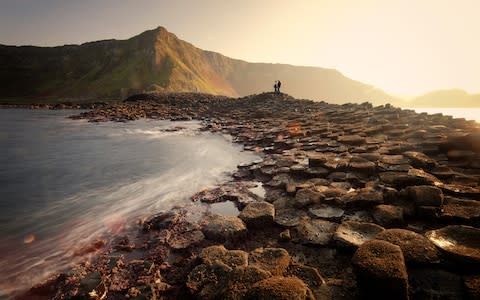
Take some time to walk the walls of Derry, admiring views of the Donegal hills. Consider a guided walk: McCrossan’s Tours (derrycitytours.com) offers valuable insights into a long and tempestuous history. Afterwards, call into the Victorian Guildhall, with its sheets of stained glass; and stock up on goods at Warehouse (thewarehousederry.com). Then hit the A6, driving through the heathery uplands of the Sperrin Mountains towards Belfast. Pause at Bellaghy to visit Seamus Heaney HomePlace (seamusheaneyhome.com), an arts centre and museum devoted to the legacy of this Nobel laureate.
Or visit Ditty’s (dittysbakery.com) in nearby Castledawson, which offers fabulous baked goods: assemble a feast, and drive a few miles south to the 17th-century National Trust property at Springhill (nationaltrust.org). From here it’s a 40-minute drive back to Belfast, and to the Merchant hotel (telegraph.co.uk/tt-merchanthotel; doubles from £180). The Northern Whig bar nearby (thenorthernwhig.com) is a stylish choice for dinner and drinks.
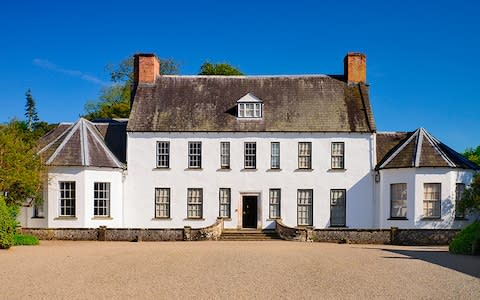
On your third morning, explore Titanic Belfast (titanicbelfast.com). This is a key city attraction, offering as it does an absorbing portrait of the ill-fated liner, which was launched in 1911. Wander around the museum – and don’t miss the SS Nomadic, the last remaining ship of the White Star Line. The ferry port is now just a stone’s throw away.
The Dublin hinterland
From Dublin Port, swing south on the N11. You’ll see the superlative scenery of County Wicklow open up – to the left, glimpses of the coast and Irish Sea; to the right, the uplands of the Wicklow Mountains and the distinctive peak of the emblematic Sugarloaf.
Two gardens of national significance lie just off the N11. Mount Usher Gardens (mountushergardens.ie), romantic and sylvan in its sheltered valley, is 30 minutes south of Dublin; a little further on, the National Botanic Gardens maintains a rural campus in the deep, acidic soil of Kilmacurragh (botanicgardens.ie); both come with pretty tea rooms.
From Kilmacurragh, follow the R755 into the uplands towards Glendalough (heritageireland.ie), in the heart of the Wicklow Mountains National Park. Part ancient monastic site, part nature reserve, Glendalough is one of Ireland’s most atmospheric places: spend time walking the Upper and Lower Lakes, drinking in the glorious scenery, and absorbing a long history. From here, it’s just an hour’s drive on the R756, over the saddle of the mountains and down again to Cliff at Lyons (cliffatlyons.ie; doubles from £175), a hotel buried deep in the countryside. Stretch your legs with a walk along the towpath of the Grand Canal, before dinner in the hotel’s converted orangery.
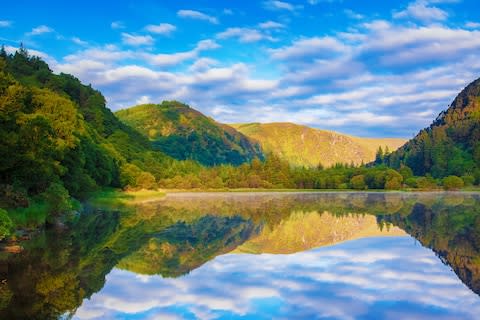
In the morning, venture onto Dublin’s M50 orbital motorway and north on the N2. Stop in Slane for an early lunch at George’s Patisserie (georgespatisserie.com), and perhaps a tour of the Slane distillery (slaneirishwhiskey.com), before exploring the Boyne valley. This is the site of Newgrange (heritageireland.ie), the venerable passage tomb that has stood on the north bank of the river for 5,000 years; the visitor centre here richly repays an unhurried visit. A little further on lies the Oldbridge estate, site of the 17th-century Battle of the Boyne (battleoftheboyne.ie): pause here for excellent walks through parkland, and comfortable tea rooms.
Then it’s back towards Dublin on the M1, turning for the seaside village of Howth. Take a walk on the pier, with its views to the distinctive outline of Ireland’s Eye island, before checking in at the King Sitric (telegraph.co.uk/tt-kingsitric; doubles from £130), with its sea-view rooms and seafood menus. Spend the following morning in Howth: the cliff walks here are second-to-none, with wonderful views south to the sweeping curve of Dublin Bay; and the steep village streets are worth exploring. Take some fish and chips onto the pier – or call into The House (thehouse-howth.ie) for a more substantial lunch, before driving the twelve or so miles south to Dublin Port and your ferry.
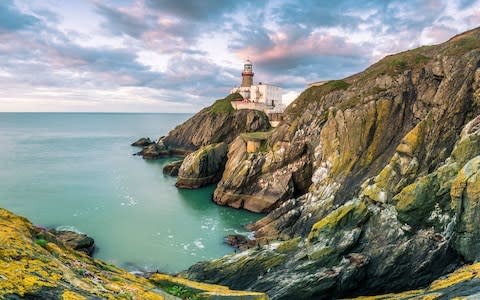
Rosslare for the sunny south-east
From the ferry at Rosslare, drive for an hour or so directly to historic Waterford city, with its spacious quays and historic architecture: and visit Waterford Treasures (waterfordtreasures.com), a trio of excellent museums which illuminate the long history of this fascinating city. Then swing west and south through the heart of County Waterford, with the dramatic Comeragh Mountains rising to your right, until the Gothic outline of Lismore Castle appears on the horizon. The castle gardens (lismorecastlegardens.com), all steep slopes and yew avenues, are well worth exploring; and so too is the castle’s excellent arts centre, and venerable St Carthage’s Cathedral in Lismore town. From here, it’s a short half-hour hop down to the coast at Ardmore, where the Cliff House Hotel (telegraph.co.uk/tt-cliffhouse; doubles from £300) clings to the edge of the sea. This is a hotel famous for its Michelin-starred dining, so bag a table with a view, and prepare to enjoy yourself.
In the morning, a marvellous hike on Ardmore’s looped one-hour cliff path – before a leisurely drive north and east along the Waterford coast. This is the Copper Coast, named for the Victorian-era copper mines hereabout. Today, the area is protected as the Copper Coast Geopark (coppercoastgeopark.com) – and it’s full of delights: the beautiful horseshoe bay at Kilmurrin; the wide Blue Flag sands at Tramore; the Bay Café (discoverdunmore.com) at Dunmore East with its deep bowls of seafood chowder; and bustling Dungarvan, with its bay, boats, quays and fine stone bridge. Take your time to explore before fetching up at Faithlegg House Hotel (telegraph.co.uk/tt-faithlegg; doubles from £125), set on its own estate just east of Waterford city.
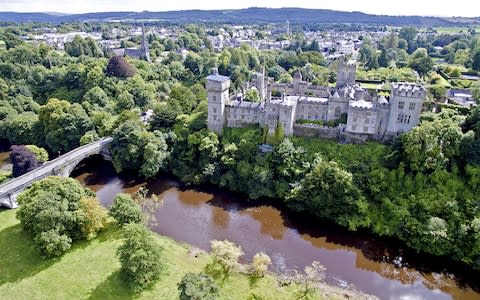
On your final morning, drive the couple of minutes to Passage East, where the tiny ferry hops across Waterford Harbour to County Wexford. If you have time, explore the long, narrow peninsula of Hook Head stretching far into the Atlantic, and culminating in its dramatic lighthouse; if not, then make straight for the nearby Tintern Abbey (heritageireland.ie), a medieval Cistercian monastery named for its famous Monmouthshire mother house. This is a truly beautiful place, with its evocative ruins, wooded paths and delightful Conclough walled garden, where you can pick up unusual plants for sale; most of all, don’t miss the Abbey’s friendly café, with its fabulously tangy Tunisian orange-and-almond cake.
10 British drives you must tackle in your lifetime
From here, it’s just a half-hour drive to Wexford town, where you can take a peep at the National Opera House (nationaloperahoue.ie). This is a state-of-the-art building, tucked modestly behind old Wexford street frontages, and home to the famous Wexford Festival Opera, which takes place each autumn. Take a peep at the spectacular walnut-clad auditorium, and grab a coffee overlooking the roofs of the town, before driving the twenty-odd minutes back to the ferry at Rosslare.

